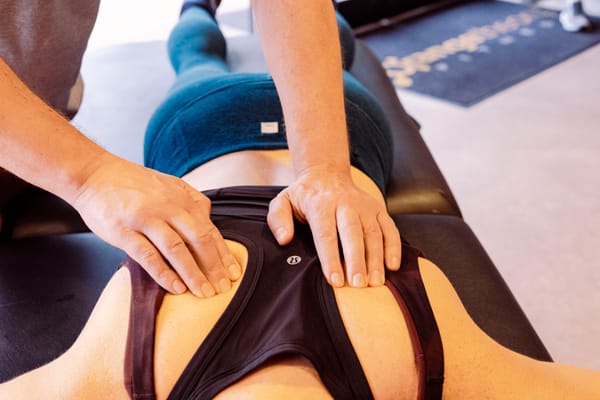
Treating TMJ Syndrome
Temporomandibular joint (TMJ) disorder is like a squeaky hinge on a frequently used door.
What is Temporomandibular joint (TMJ) Syndrome
Temporomandibular joint (TMJ) syndrome refers to a condition that affects the TMJ, which connects the jaw bone to the skull.
Temporomandibular joint (TMJ) disorder is like a squeaky hinge on a frequently used door. Just as a door hinge connects the door to its frame, allowing it to swing open and close smoothly, the TMJ connects your jawbone to your skull, enabling you to open and close your mouth, chew, and speak. Over time, excessive use or stress can cause the hinge to squeak and resist smooth movement; similarly, strain or misalignment in the TMJ can lead to pain, stiffness, and a decrease in the jaw's ability to function correctly.
Imagine if that same door’s hinge wasn't just squeaky and misaligned. It might creak loudly, resist movement, or even get stuck. The clicking, popping, or locking sensations many experience with TMJ disorders.
Just as you would address a faulty door hinge by realigning it, lubricating it, or even replacing it if necessary, treating TMJ disorders involves alleviating the pressure, correcting the alignment, and reducing the pain through therapeutic techniques to restore the natural, smooth movement of the jaw.
Symptoms of TMJ
Below, I've listed common symptoms of TMJ that I found my clients describing during the ten-plus years of using the Iler Method® to treat pain caused by TMJ dysfunction.
- Jaw pain or tenderness
- Jaw clicking or popping sounds on the side of your face when moving the jaw
- Difficulty or experiences severe while chewing
- Limited ability to open or close the mouth
- Rheumatoid arthritis
- There is a higher risk of severe pain and fullness in the ears
- Ear pain
- Headaches, particularly in the temple region
- Facial pain
- Hearing loss
- Lower jaw muscle stiffness
- Changes in the way upper and lower teeth fit together (bite misalignment)
- Locking of the jaw with affected joint, making it difficult to open or close the mouth temporarily
- Thorasic Outlet Syndrom (TOS) is often associated with neck and shoulder pain related to TMJ dysfunction.
Trigger Point Therapy for TMJ Syndrome Relief
The good news is Temporomandibular Joint Syndrome (TMJ) can be effectively managed through non-invasive approaches, with trigger point therapy playing a pivotal role in providing relief.
Unlike medical interventions, this form of therapy targets specific muscle knots and trigger points associated with TMJ, offering a natural and tailored approach to pain management.
Rather than relying on nonsteroidal anti-inflammatory drugs (NSAIDs) for symptom relief, trigger point therapy directly addresses muscle tension and discomfort caused by TMJ.
Patients can avoid surgical interventions by opting for this holistic treatment option instead of seeking an oral surgeon.
While tricyclic antidepressants manage TMJ-related pain and sleep disturbances, trigger point therapy offers a drug-free alternative, focusing on the root cause of discomfort.
Transcutaneous electrical nerve stimulation (TENS) can complement trigger point therapy by providing non-surgical relief through low-level electrical currents that relax jaw and facial muscles.
Patient education remains essential in TMJ management. It allows individuals to make informed decisions about their care and comprehensively understand this complex condition.
TMJ Massage Benefits
Pain Relief: TMJ massage therapy alleviates jaw pain by targeting specific muscles associated with temporomandibular joint dysfunction. It provides immediate relief and promotes more comfortable jaw function.
Muscle Tension Reduction: Through targeted techniques, TMJ massage helps to release tension in the jaw, face, and neck muscles, contributing to improved flexibility and reduced stiffness in the temporomandibular joint.
Enhanced Jaw Mobility: Massage therapy can enhance the range of motion in the jaw by addressing restrictions and promoting smoother movements. Removing these restrictions is particularly beneficial for those who experience difficulties opening or closing their mouths.
Stress Reduction: The relaxation induced by TMJ massage extends beyond the jaw, helping to alleviate overall stress levels. Reduced stress can contribute to a more relaxed jaw and decreased likelihood of clenching or grinding teeth.
Headache and Earache Relief: TMJ massage may reduce associated symptoms like headaches and earaches by addressing muscle tension and promoting better jaw alignment, improving myofascial pain.
Muscles Treated for TMJ Dyfunction
1. Masseter Muscle:
- Location: Along the jawline, near the angle of the jaw.
- Technique: Apply careful, sustained manual therapy pressure to these points to release tension and reduce symptoms of jaw pain.
2. Upper Trapezius Muscle:
- Location: At the top of the shoulders and neck.
- Technique: Involves identifying sensitive knots within the muscle, typically along the shoulders and back of the neck, and applying focused, sustained pressure to these areas to release tension, reduce discomfort, and improve range of motion.
3. Levator Scapuli:
- Location: It is at the back and side of the neck, extending from the cervical spine down to the upper corner of the scapula (shoulder blade).
- Technique: Releasing tension in this neck muscle contributes to jaw discomfort due to its connection to neck and shoulder alignment.
4. Scalene Muscles:
- Location: The scalene muscles are a group of three pairs of muscles located on each side of the neck, running from the cervical vertebrae to the first two ribs.
- Technique: Apply direct, sustained pressure to specific tender spots in the jaw and related muscles to relieve tension and reduce jaw pain and dysfunction.
5. Sternoclidomastoid muscle:
- Location: The sternocleidomastoid muscle is located on each side of the neck, extending from the sternum (middle of the chest) and clavicle up to the mastoid process of the skull, just behind the ear.
- Technique: This technique involves carefully locating and applying sustained pressure to the muscle's trigger points, often found along its length, to release tension and alleviate associated symptoms like neck pain, headaches, and referred discomfort.
Communication During Treatment
Effective communication between the therapist and client about comfort levels and specific areas of concern is critical during TMJ massage sessions, especially those using the Iler Method. This method prioritizes clear communication by creating an environment conducive to dialogue.
Unlike typical massage settings, Iler Method sessions do not feature music, and clients remain dressed in comfortable clothes or sportswear, making it easier for them to participate in conversation.
Additionally, these sessions are conducted in well-lit rooms rather than the dim settings often associated with traditional massage therapy. Well-lit rooms facilitate open communication and address each client’s needs and discomforts. This focus on interaction helps tailor the treatment to the individual’s specific issues, enhancing the effectiveness of the therapy in alleviating TMJ-related discomfort.
Finding a qualified therapist specializing in TMJ pain relief is essential for ensuring that the therapy is both communicative and highly beneficial.
Final Thoughts: TMJ MassageTherapy
Trigger point therapy and TMJ massage offer valuable, noninvasive relief for those suffering from temporomandibular joint dysfunction. These therapies can significantly reduce pain, stiffness, and dysfunction by incorporating precise techniques to alleviate muscle tension and improve jaw mobility.
The Iler Method is one approach that effectively utilizes these techniques. It focuses on specific muscles with targeted pressure to provide relief without requiring drugs or surgical interventions. This holistic approach is central to managing TMJ symptoms, emphasizing the importance of a comprehensive treatment plan.
TMJ massage sessions are highly beneficial for individuals dealing with TMJ disorders, leading to substantial improvements in quality of life. These sessions, which include methodologies like the Iler Method, relieve pain, enhance jaw function, and help reduce stress, which is vital for long-term symptom management.
Sessions combine targeted trigger point massage with client education to ensure a thorough understanding and effective handling of this complex condition.
Massage for TMJ: FAQs
Does Massage help TMJ?
Massage therapy can help alleviate TMJ (Temporomandibular Joint) discomfort by targeting specific muscles, releasing tension, and improving jaw mobility and relaxation.
Does Massage help with TMJ?
Massage therapy can help alleviate TMJ (Temporomandibular Joint) discomfort by targeting specific muscles, releasing tension, and improving jaw mobility and relaxation.
Do massages help with TMJ?
Massages, particularly those targeting the jaw and facial muscles, can help alleviate symptoms of TMJ by reducing muscle tension and increasing circulation in the affected area.
Where do you massage for TMJ?
For TMJ relief, Massage is focused on the jaw muscles, particularly the masseter and temporalis, and surrounding areas like the neck and shoulders to reduce overall tension.
What is a TMJ knot in the jaw?
A TMJ knot in the jaw refers to a trigger point, a localized tension, and pain within the jaw muscles that is often responsive to targeted trigger point therapy.
Disclaimer -
Please note that at Iler Method® Therapy, we specialize in massage therapy and related techniques. All clients must understand that we are not medical professionals, and our services should not be seen as a substitute for medical advice, diagnosis, or treatment. Our practices are designed to support and complement your overall health, but they do not replace professional medical consultation when needed.




